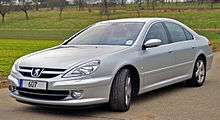Executive car
Executive car is a British term for an automobile larger than a large family car. In official use, the term is adopted by Euro NCAP, a European organization founded to test car safety.
History
The term was coined in the 1960s to describe cars targeted at successful professionals and middle to senior managers, often as a company car but retaining enough performance and comfort to be desirable in their own right. Ford identified some of the higher-equipped Cortina models as Executives. An example of Ford's executive car of the 1970s and 1980s was the Granada. Larger Triumphs such as the 2000 and 2500 firmly fitted into this category, as did some of the larger Vauxhall models from the VX4/90 and Ventora through to the Carlton. Other British executive cars of the 1960s and 1970s were the Rover P6 range and the SD1.
The executive car was seen as aspirational, hence the emphasis on standing out from the crowd—but also a business tool enabling its users to exploit Britain's evolving motorway network. Early executive cars typically offered engines of between 2.0 and 3.5 litres in size, compared with 1.6 to 2.4 litres of a large family car; these days the average family saloon is more likely to be a two-litre car with executive cars generally starting at around 2.5 litres, although in some markets such as Italy and France where tax structures make large engines prohibitively expensive to own and run there are many 2.0-litre executive vehicles.
Overview
Body styles
In general, executive cars are 4-door sedans. Some manufacturers seek to differentiate their offerings by making them as estate variants, or with 5-door hatchback bodies—in particular Rover, Saab, Renault and Citroën formerly have been known to prefer such body styles, with Ford also offering such models through the 1990s, and Audi and BMW have recently offered such body styles for their executive cars. Until the 1990s, some models were also available as 2-door coupés.
Market situation
While executive cars were popular in Europe in the beginning of the 1970s, with most major manufacturers and brands having an entry in this category, the fuel crises hampered their sales. Gradually, the executive cars became more premium vehicles, with basic versions with less equipment and smaller engines disappearing from the market.
On the other hand, large family cars grew in size, being offered with larger engines (including V6 units, considered premium in Europe) and higher equipment levels, taking over the role of less premium executive cars due to still lower prices. These included executive cars from mainstream manufacturers, such as Opel/Vauxhall Omega and Ford Scorpio, with the remaining models being positioned mostly as premium cars and coming from brands specializing in larger/more expensive vehicles. Ford's decision to discontinue the Scorpio in 1998 came just before the launch of the Jaguar S-Type, as Ford owned Jaguar at the time, and also a short time before it took over Volvo, which sold the similar sized Volvo S70/V70.
The French manufacturers, Citroën and Renault, continued to offer executive cars. A growing number of Asian manufacturers started offering executive cars, such as Kia Cadenza and Hyundai Genesis.
Japanese large/family cars cars such as Toyota Camry/Lexus ES and Honda Legend have been withdrawn from European markets, while Toyota continues to sell the Lexus GS.
Other corresponding classes
The equivalent class for cars in Germany is "Obere Mittelklasse" (lit. upper-middle class) as defined by the German federal authorities. Another designation for the class is E-segment, within the classification that assigns a letter of the Latin alphabet to every class of car, starting with "A" for city cars. This designation is also often used in several other European countries, especially by automotive media with ties to German publications. German standards define such vehicles to be between 4.8 and 5.0 metres in length and with list prices of between EUR 30–60,000.
In France, these vehicles are known as "Grande Routière", a class of comfortable long distance cars that first emerged on the French market in the 1930s. The Citroën DS is a prominent example.
In the United States and Canada, these vehicles occupy the 1 million vehicle/year Mid-luxury segment. German exports are competitive in this sector and use 'entry-level-luxury' and 'mid-luxury' as the base of their ranges. Because brand perception of value is the key selling proposition, Japanese manufacturers have established separate luxury brands such as Infiniti, Lexus, and Acura to compete in this segment.
Rental car classification segments that generally correspond with it are 'P' (Premium) and 'L' (Luxury), though it has to be noted that these classifications are often applied quite liberally by rental companies.
The Australian term for cars this size is simply 'large car' size.
Cars bigger than executive in Europe
A saloon car larger and/or more expensive than an executive car would be classified as a luxury car in Europe. In Germany, these cars are referred to as Oberklasse ("upper class").
Compact executive cars
Within the large family car class, premium cars such as the Audi A4, BMW 3 Series, Jaguar XE, Mercedes-Benz C-Class and Volvo S60 are sometimes referred to as compact executive cars in the United Kingdom,[1] reflecting their status, equipment amount, materials used and relative size compared to mainstream large family cars and regular executive cars. In North America, such models can be labelled entry-level luxury cars, compact or sometimes mid-size luxury cars, or alternatively near-luxury cars, though this classification depends more on price than on size.
See also
References
- ↑ "What Car? Car of the Year 2006 – Best compact executive". What Car?. 20 January 2006. Retrieved 9 May 2012.
_sedan_(2016-03-05)_02.jpg)
_3.0_TFSI_quattro_hatchback_(2016-01-07)_01.jpg)


